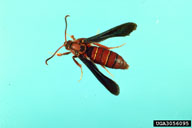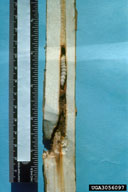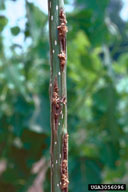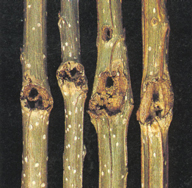Poplar clearwing borer
Paranthrene dollii (Neumoegen) (Lepidoptera: Sesiidae)
Orientation to pest
Poplar clearwing borer, Paranthrene dollii (Neumoegen), is a native North American clearwing moth that occurs principally in the southern United States, where it infests the base and root-collar area of young cottonwoods (Populus) and black willow (Salix nigra Marshall). Eggs are laid in bark crevices, and larvae bore in the wood and pith, making open tunnels up to 15 cm long. Heavily infested trees are mechanically weakened and subject to wind and ice breakage. Damage is sometimes severe in cottonwood plantations and nurseries, and in the southern states losses may reach 12% of nursery stock. There is one generation per year.
Hosts commonly attacked
This borer attacks cottonwoods (Populus) and black willow (S. nigra).
Distribution
This borer occurs in the southern United States, from Florida to Texas.
Images of poplar clearwing borer
| Figure 1. Adult of poplar clearwing borer, Paranthrene dollii | Figure 2. Larva of poplar clearwing borer | Figure 3. Frass being expelled from larval tunnels of poplar clearwing borer | Figure 4. Enlarged entrance holes in stem of cottonwood seedling caused by larvae of Paranthrene dollii. |
Important biological control agents related to this pest species
One braconid, Apanteles paranthrenidis Muesebeck, is known from this borer's larvae.
Web links for information on poplar clearwing borer
- Bulletin on ForestPests.org | USDA Forest Service, Southern Region
Covers biology and control of several cottonwood borers, including P. dollii. - BugwoodWiki Article | wiki.bugwood.org
Articles
- Eroles-Harkins, L. 1983. Biology and life history of the cottonwood clearwing borer, Paranthrene dollii (Neum.) (Lepidoptera: Sesiidae), in the laboratory and a cottonwood nursery in Mississippi. MS thesis. Mississippi State University, 106 pp.
- Nebeker, T. E. and L. Eroles-Harkins. 1988. Daily and seasonal flight of male Paranthrene dollii (Lepidoptera: Sessiidae), monitored by pheromone traps. Florida Entomologist 71(3): 376-380.







